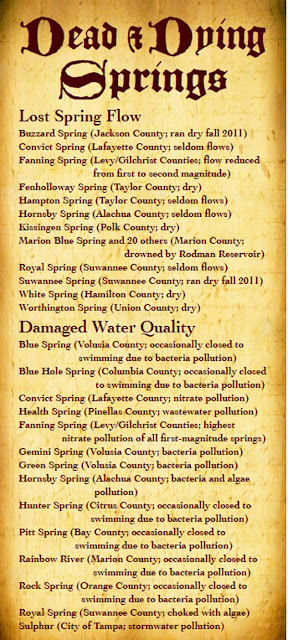For the next seven years, I talked about the rights of nature idea to anyone and everyone who seemed even slightly receptive. I bulldogged the idea because I knew that Florida was on the fast track to lose our priceless freshwater springs—the largest such concentration of springs on the planet—and because I couldn't stand by and do nothing as the springs were damaged by overpumping from the Floridan aquifer and pollution by people and industry (including, but not limited to, agriculture).
Florida's Eden, a group of artists who had joined forces in Gainesville to create awareness of springs problems, produced the "Dead and Dying Springs" graphic above. The list of dead and dying springs is a reminder for anyone who needs it that we human beings are playing an active role in the destruction of these ecosystems.
I felt like I was talking into empty space for most of those seven years. When I mentioned rights of nature, people would smile and nod; sometimes a more engaged person would ask a question or two, but that would be the end of it. The impression I got from these conversations was that people thought it was a novel idea but they didn't think it was something that would ever catch on. Every now and then, though, I'd run into someone who would resonate with it. Those people gave me hope.
Fast forward almost seven years from 2013, and I saw a Facebook post from Chuck O'Neal in the Orlando area, who—coincidentally or not—I had met at Democracy School when we sat next to each other. Chuck was musing about the idea that he might want his activist's legacy to be the establishment of a rights of nature movement in Florida. I immediately messaged him, "You need to get in touch with Thomas Linzey."
I had been in touch with Thomas about the possibility of having the Ichetucknee Alliance, the group I work for, get involved with RON, but the directors of that small group weren't interested in taking up the rights of nature banner and had several good reasons for not doing so.
I exchanged several more messages with Chuck, and in each one I stressed, "You need to talk to Thomas Linzey." I gave Thomas's contact information to Chuck, and eventually the two connected—and what a connection that turned out to be!
Chuck arranged for Thomas to come to Florida and hosted a meeting at his house in which Thomas gave a crash course in RON to a small crowd of people who were intrigued with the idea. It seems like things moved really fast after that, but actually it took almost a year for the big event to unfold: the Florida Rights of Nature Convention (RONcon), held in February 2020 at the University of Florida Law School's annual public interest environmental conference.
I've heard from one person who attended those events in the past that the second day of that conference, which was the day RONcon was held, usually has an attendance of about 35 people. This year, we filled a large lecture hall to standing room only capacity!
Following RONcon, a group of people who were particularly interested in and committed to starting a rights of nature movement in Florida got together and with Chuck's leadership, we formed the Florida Rights of Nature Network. There are now people working on bills of rights for local rivers in all areas of Florida, from the Panhandle to the southern part of the state!
And the person who called these ideas "fluffy bunnies" has now admitted that the rights of nature movement has momentum in Florida.
But what exactly are these bills of rights for natural systems supposed to do? Stay tuned for Part 3 of this blog series.




No comments:
Post a Comment